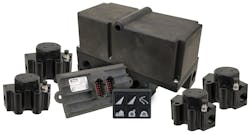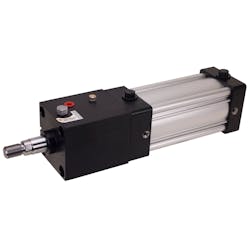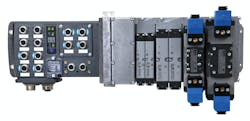Pneumatics Continue to Adapt to Market Needs
A number of market trends are impacting the pneumatics industry, from increased integration of electronics to requests for more efficient and reliable system designs. And the pneumatics industry continues to advance technologically to meet these evolving needs.
Melissa Childers, Business Development Manager, Motion Systems Group, Pneumatic Division at Parker Hannifin spoke with Power & Motion about the technological changes taking place in the pneumatics sector as well as the market factors which could have an impact on the industry in the coming year.
*Editor's Note: Questions and responses edited for clarity.
Power & Motion (P&M): What trends or market factors do you feel had the largest impact on pneumatic component and system designs in 2023? Please explain what those trends are and how specifically they impacted the design of pneumatic.
Get More Market Insights!
This article is part of our 2023 State of the Industry coverage which reviews the market and technology trends impacting the development of hydraulic, pneumatic and electric motion systems.
Visit our State of the Industry hub for more Q&As, video interviews and industry insights.
Melissa Childers (MC): The agriculture market had one of the largest impacts on pneumatic systems in 2023. When the Russia-Ukraine war began in 2022, the market saw a price increase for row crops like corn, soybean, and wheat. Even in October 2023, the USDA (U.S. Dept. of Agriculture) published a market outlook stating: “The largest reduction for corn 2022/23 exports this month is for Ukraine, down 1.0 million tons to 27.0 million, based on the trade data from Ukraine’s Ministry of Agriculture.”
As the war continued into 2023, the shipment of U.S. farm machinery increased along with the shipment of military vehicles and spare parts. To accommodate for the outdoors, the design of pneumatic components and systems are adapted to meet the customers’ needs and requirements such as salt spray testing, cyclic corrosion testing, and vibration testing in a compact and efficient way.
P&M: How have you seen pneumatic component and system designs evolve in recent years?
MC: In recent years, we continue to see a desire for customers to increase reliability of their systems. Parker has been offering a pneumatic kneeling module solution for buses since 2007 to assist bus riders boarding buses. This solution takes the air from the bus’ supply tank through a leveling valve to inflate and deflate airbags installed on each axle of the bus using mechanics. We evolved that technology to offer the Smart Suspension™ solution launched in 2018 that electronically controls suspension systems to manage the vehicle height, improve [the] rider experience, and increase safety and productivity.
That takes us to today where we now offer [a] CTIS (Central Tire Inflation System) which is an active tire pressure control system used to improve the mobility in varying terrains by monitoring and automatically maintaining tire pressure in a system.
With the growing emphasis on efficiency and an integration with Industrial Internet of Things (IIoT), we can see the design evolution continuing to adapt and be exciting.
P&M: What are some of the key features or performance attributes your company is working to include with its pneumatic components and systems, or for which customers are asking?
MC: When we talk about key features Parker is working to include with its pneumatic components and systems, we work to simplify our designs by utilizing a complexity assessment. We work to ensure that the design is forward thinking with lots of flexibility to evolve with customer’s functional needs while maintaining compliance on functional safety requirements and cybersecurity.
Customers are asking for technologies that walks-like-a-node, talks-like-a-node, and can fit right into their circuits. We work to design for the environment, focusing on products that can reduce its carbon footprint and improve recyclability. We work to design for flow by designing for manufacturing and assembly processes with automation implementation when appropriate.
P&M: How much, if at all, are you seeing electronic alternatives taking the place of pneumatic components or systems? Can you offer some examples, and how you see this trend progressing?
MC: We are seeing electric taking the place of pneumatic components and systems in certain industries. Passenger doors for buses, coaches, and the rail industry are opened using a pneumatic solution or an electric solution. Customers typically choose pneumatic over electric door solutions for the low cost and simple integration. Customers choose electric over pneumatic door solutions because they are easier to control and are not reliant on the temperature of the air.
When we talk about the mobile space of pneumatic solutions, the relationship between pneumatic and electric solutions may require a hybrid design to support remote operations. For example, if trying to move a heavy load or concentrate energy into one accurate area, then you could take Parker’s 4MAP pneumatic cylinder, an all-purpose, light weight cylinder, to provide the force, speed, and reliability to move the load while an electric motor would control the speed and the position of the load. By simplifying the design into a system solution, this generates a more efficient solution than either component could provide independently.
P&M: Are you seeing a greater integration of electronics with pneumatic? If so, what are some examples you can share and the benefits of doing so?
MC: You bet! More customers are seeking feedback from their automation systems specifically aligned with the Industry 4.0 movement to achieve higher productivity metrics. To monitor and detect downtime in a pneumatic system before it occurs, Parker offers a PCH Portal that connects an IO-Link master to a valve manifold which allows designers to add pressure sensors, flow sensors, linear transducers, and cylinder position sensors to see the whole picture.
To maintain a pneumatic system, this solution has built-in diagnostics to detect short circuits in valves and to monitor valve cycles. By monitoring, detecting, and maintaining your pneumatic system, you will decrease operating costs and increase uptime.
P&M: Do you foresee any new trends or market factors impacting pneumatic designs in the coming year or years? If so, what are those and what impact will they have?
MC: I think the market to keep an eye on is heavy-duty trucks in the coming year. The Class 8 North American heavy truck market has had close to record breaking retail sales in 2023. From ACT Research: “Class 8 sales through the first nine months of 2023 were up 12.9% to 202,335 units, compared with 179,247 at this time in 2022.”
Some of that has to do with an associated backlog which helps dictate what truck needs to be built next. Some of that also has to do with the U.S. House of Representatives who, back in May 2023, voted to overturn the EPA’s ruling to cut emissions from heavy-duty trucks by up to 80%. While it is delayed for now, the EPA (U.S. Environmental Protection Agency) has a Clean Heavy-Duty Vehicle Program through the Inflation Reduction Act which plans to invest $1 billion to replace heavy-duty vehicles with zero-emission vehicles, to support correlating infrastructure, and to train the workforce accordingly until 2031.
The transportation market uses several pneumatic component and system solutions to operate safely such as air brake systems, kneeling a vehicle, opening a door, even honking a horn. Whether heavy emission or zero emission, air systems on trucks are likely to stay due to the product robustness, costs, and maturity of the products. By designing pneumatic solutions with performance, lifecycle, production capacity, functional safety, customer expectations, and cybersecurity, the impact you could see will be positive with [the] latest heavy truck forecasts expecting 20% growth in 2026.
P&M: Are there any economic/market factors you are concerned could negatively impact the pneumatics industry in the coming year?
MC: Yes, there are several economic factors that could negatively impact the pneumatics industry like fluctuations in commodity pricing and interest rates along with trade policies and tariffs. Decreased economic wealth, increased commodity pricing, and changes to trade policies and tariffs that impact importing and exporting of products could negatively impact the pneumatics industry. It is all about staying resilient.
P&M: How do you see the pneumatics market in general performing in 2024?
MC: I expect the pneumatics market to strengthen in performance in 2024. We are seeing growth from the previous year in our system solutions for our door systems for the bus and coach market as well as our CTIS technology.
We must continue to work on hybrid solutions as we approach the world of electrification to maintain the relevance of pneumatic solutions in the years to come, working together for a better tomorrow.
Editor’s Note: Power & Motion's WISE (Workers in Science and Engineering) hub compiles our coverage of workplace issues affecting the engineering field, in addition to contributions from equity seeking groups and subject matter experts within various subdisciplines.
About the Author
Sara Jensen
Executive Editor, Power & Motion
Sara Jensen is executive editor of Power & Motion, directing expanded coverage into the modern fluid power space, as well as mechatronic and smart technologies. She has over 15 years of publishing experience. Prior to Power & Motion she spent 11 years with a trade publication for engineers of heavy-duty equipment, the last 3 of which were as the editor and brand lead. Over the course of her time in the B2B industry, Sara has gained an extensive knowledge of various heavy-duty equipment industries — including construction, agriculture, mining and on-road trucks —along with the systems and market trends which impact them such as fluid power and electronic motion control technologies.
You can follow Sara and Power & Motion via the following social media handles:
X (formerly Twitter): @TechnlgyEditor and @PowerMotionTech
LinkedIn: @SaraJensen and @Power&Motion
Facebook: @PowerMotionTech

Leaders relevant to this article:





